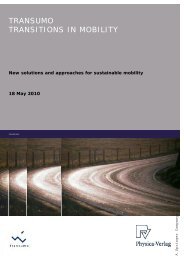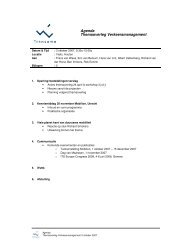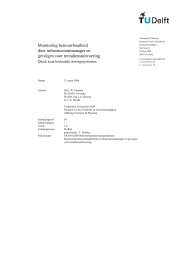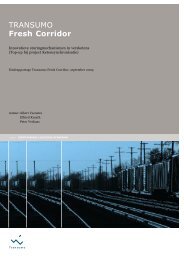Casestudie Breakdown prediction Contell PILOT - Transumo
Casestudie Breakdown prediction Contell PILOT - Transumo
Casestudie Breakdown prediction Contell PILOT - Transumo
Create successful ePaper yourself
Turn your PDF publications into a flip-book with our unique Google optimized e-Paper software.
Daytime and nighttime minimum values are very similar to each other. The reason for<br />
this similarity is based on the kind of external user influences. Most influences are<br />
caused by door openings or the insertion of warm samples, so that the minimum<br />
temperature remains uninfluenced. 82<br />
The calculation of daily minimum values also contains several remarkable changes.<br />
First of all, daytime and nighttime values contain an exceptional change in minimum<br />
temperature of more than 1°C at the end of September. Regular changes from one<br />
day to another are normally at most 0.2°C, so that this change should be notified. In<br />
fact, this change in minimum temperature indicates the already introduced global<br />
minimum temperature that occurred on September, 22 nd .<br />
In addition to that, some other remarkable changes do exist. The first one is a rise in<br />
minimum temperature about one week, before the global minimum occurs. Moreover,<br />
the already mentioned change at the end of November is also eye-catching again. As<br />
maximum as well as minimum temperatures are remarkably different, a change of<br />
general temperature level must have taken place. The last eye-catching factor is that<br />
the calculated minimum values contain a general trend.<br />
The mean daytime and nighttime values appear to be very similar at first sight. But a<br />
closer look discovers some significant higher peaks in daytime data, which are not<br />
recognizable at nighttime. The reason for these peaks cannot be obtained for sure,<br />
but presumably they are caused again by external user influences like door<br />
openings.<br />
But even the uninfluenced nighttime values are faced with higher variations than the<br />
already reviewed minimum and maximum temperatures. This complicates the<br />
identification of significant changes. But again the changes from the end of<br />
September and November are recognizable. Moreover, the mean values also contain<br />
the mentioned trend.<br />
The last promising measure is the standard deviation. Again, the daytime values<br />
contain several high peaks that have to be traced back on door openings. By<br />
contrast, the graph of the standard deviation at nighttime indicates the changes from<br />
the end of September and November more clearly, than any other introduced<br />
measure.<br />
82 See section 2.4.2 for details<br />
92
















